Index Surge: Amplifying Your Insights
Stay updated with the latest trends and news across various industries.
When Makeup Meets Science: The Surprising Chemistry Behind Your Favorite Products
Discover the secret science in your favorite makeup products and unlock the chemistry that enhances your beauty routine!
The Science of Shine: How Chemistry Enhances Your Lip Gloss
The science of shine in lip gloss begins with the careful selection of ingredients that provide both aesthetic appeal and functional benefits. At the core of these products are various types of waxes, oils, and pigments that create the perfect texture and finish. Commonly used waxes, like beeswax and carnauba wax, not only add a glossy effect but also help to stabilize the formulation, ensuring that the lip gloss stays smooth and creamy. Additionally, the inclusion of emollients such as jojoba oil and shea butter delivers hydration to the lips, providing a radiant look while also enhancing comfort.
Chemistry further enhances the performance of lip gloss through the use of light-reflecting particles, which contribute to that irresistible shine. These particles, often made from mica or synthetic alternatives, scatter light in such a way that they create a shimmering effect on the lips. Moreover, modern formulations often feature polymers that increase the longevity of the gloss, ensuring that the shine lasts throughout the day without becoming sticky. By blending innovation with practical chemistry, lip gloss manufacturers can create products that not only look great but also feel good to wear, exemplifying the fascinating intersection of beauty and science.

Behind the Glow: Understanding the Chemistry of Highlighters
In the world of cosmetics, few products can transform a look as dramatically as highlighters. These magical beauty tools are designed to catch the light and add radiance to the skin. But what exactly makes highlighters glow? The secret lies in their unique formulation, which often includes light-reflecting pigments and fine shimmer particles. These ingredients work together to create that coveted luminous finish, enhancing the skin's appearance and giving it a youthful glow. Understanding the chemistry of highlighters not only helps you choose the right product but also allows you to appreciate the artistry behind their formulation.
Highlighters come in various forms such as powders, creams, and liquids, each with its own set of properties. For instance, powder highlighters are typically rich in mica, a mineral that reflects light beautifully. On the other hand, creams and liquids often contain silicone-based ingredients, which provide a smooth application and a dewy finish. When choosing a highlighter, consider factors like your skin type and the desired intensity. Whether you prefer a subtle sheen for everyday wear or a bold, blinding highlight for special occasions, understanding the chemistry of these products can elevate your makeup game and help you achieve the perfect glow.
What’s Really in Your Foundation? Unpacking the Ingredients and Their Effects
When it comes to your makeup routine, foundation is often the keystone product that sets the tone for your entire look. However, have you ever stopped to consider what’s really in your foundation? Many formulations contain a variety of ingredients, ranging from natural extracts to synthetic compounds. Common components include pigments for color, emollients for moisture, and various agents for texture and application ease. It's essential to read the label and understand each ingredient, as some can affect your skin health in unexpected ways, from causing breakouts to triggering allergic reactions.
For instance, many foundations contain silicones, like dimethicone, which provide a smooth finish but may clog pores for sensitive skin types. On the other hand, mineral foundations often use natural ingredients like zinc oxide and titanium dioxide, which can offer additional sun protection. Furthermore, some brands incorporate active ingredients like hyaluronic acid or salicylic acid aimed at enhancing skin hydration or targeting acne. Thus, being aware of what’s inside can not only help you choose the best product for your skin type but also contribute to your overall skin health.